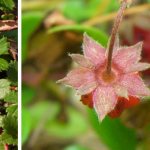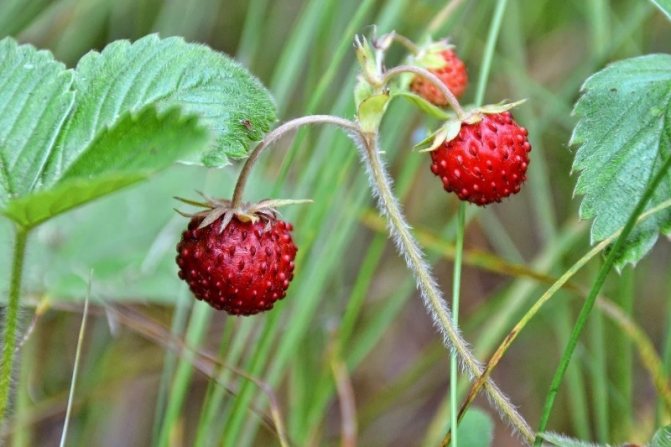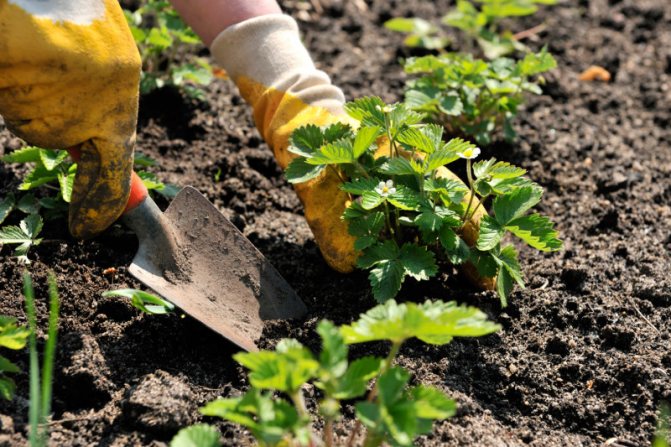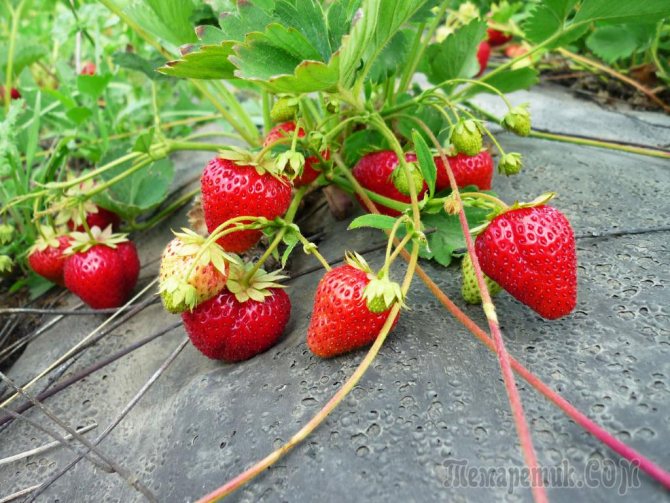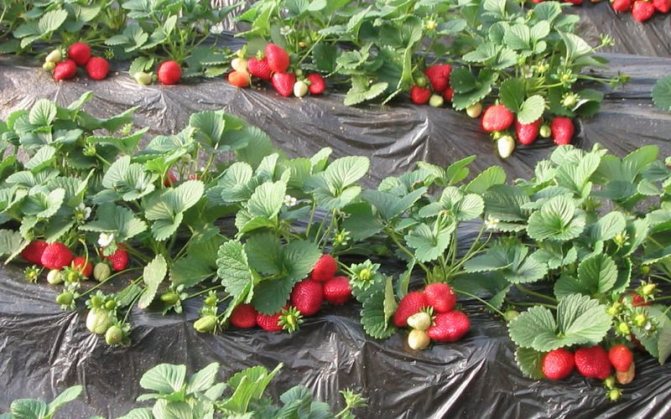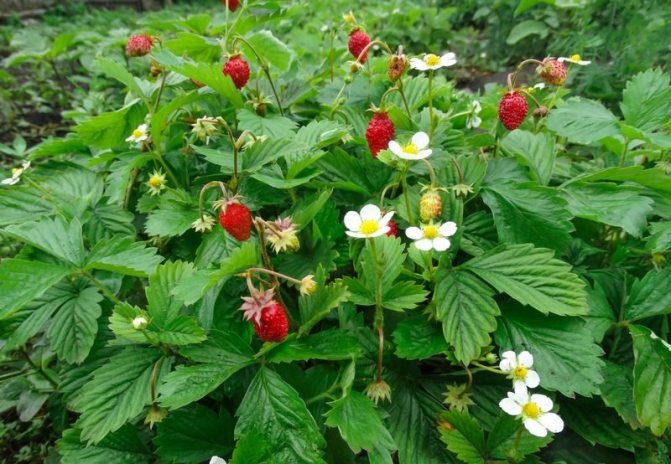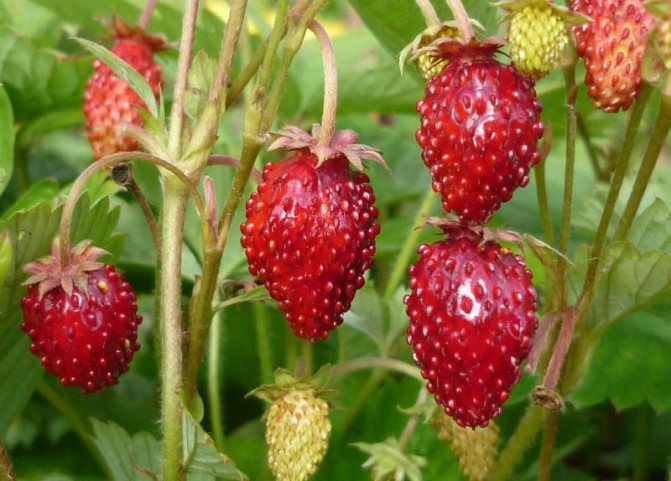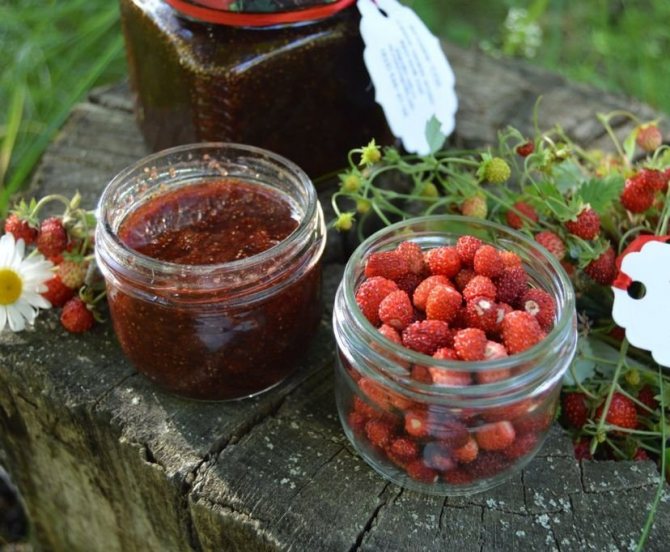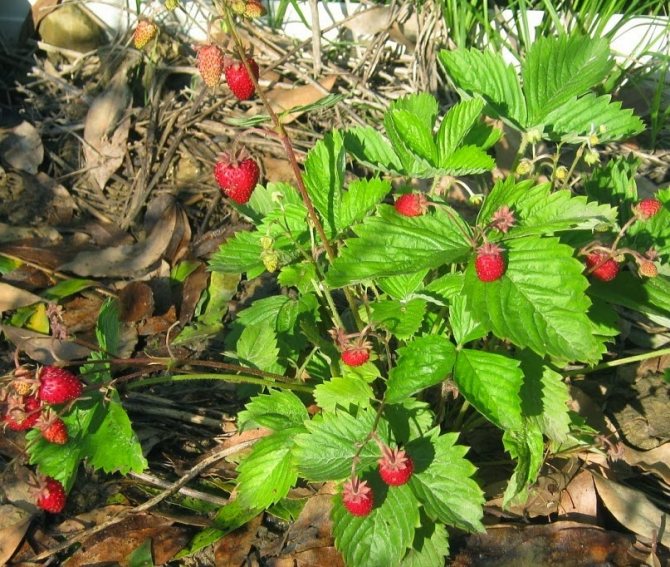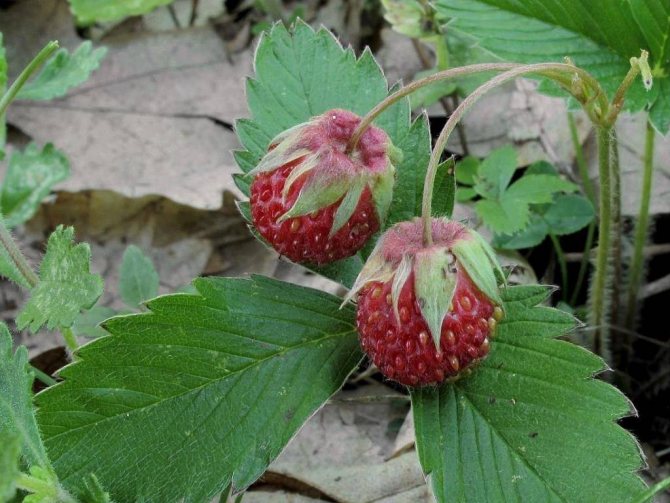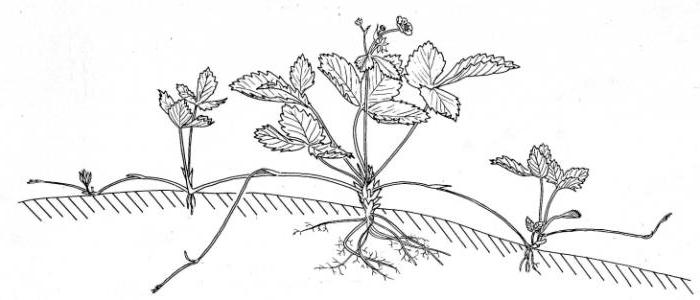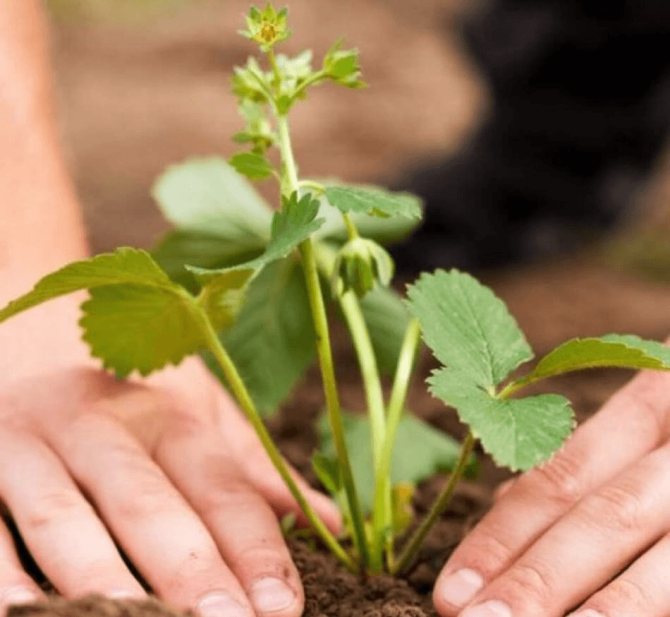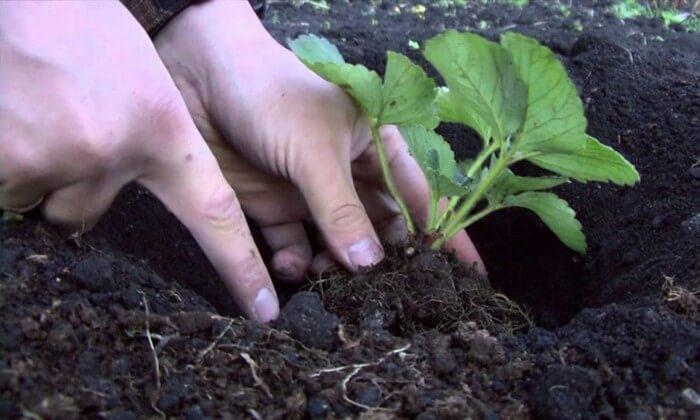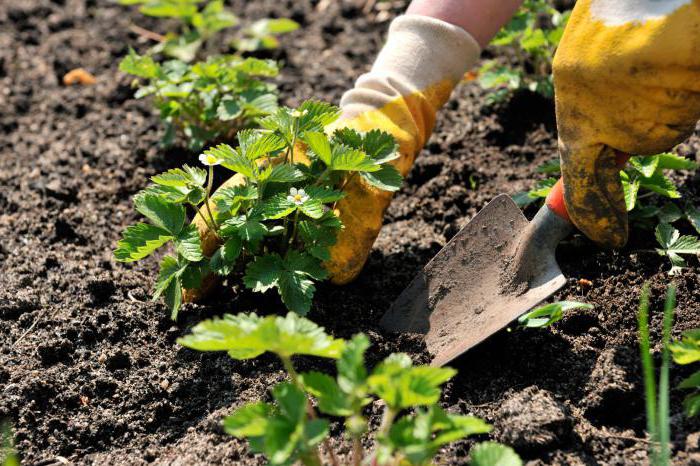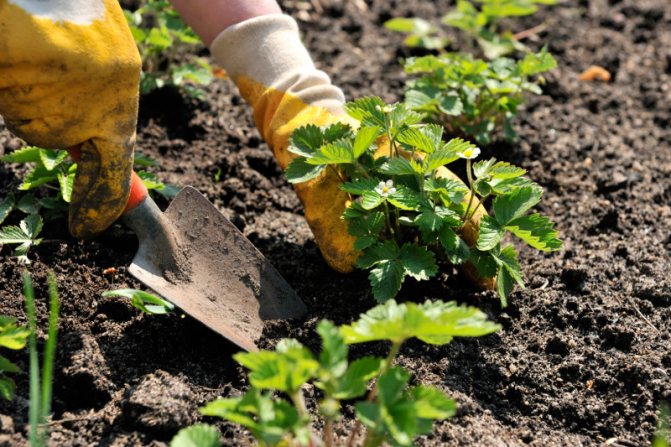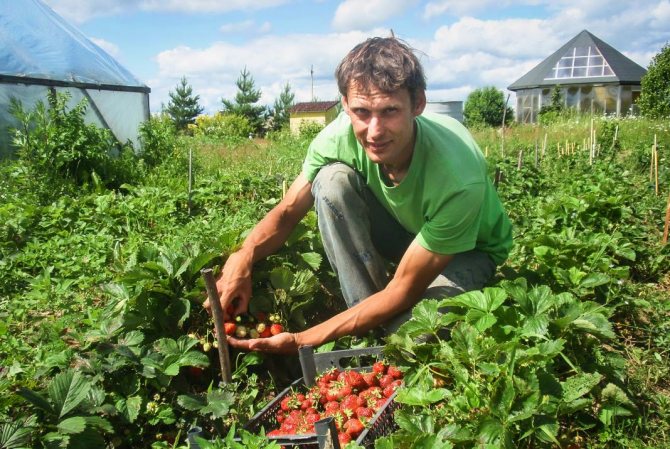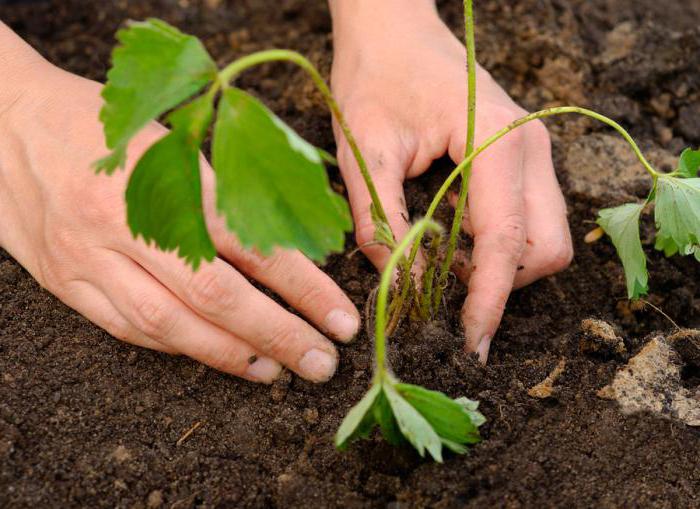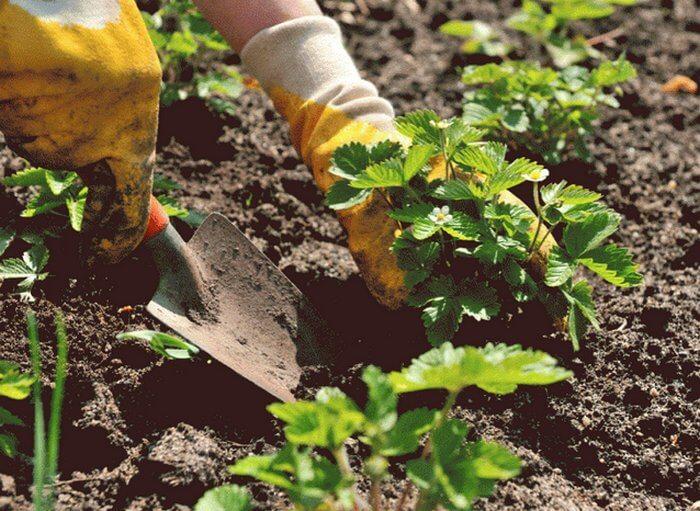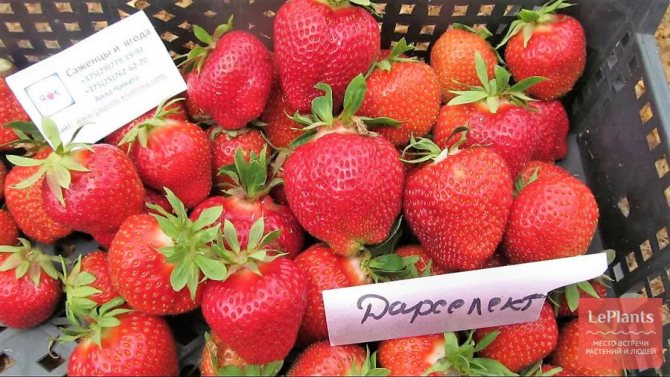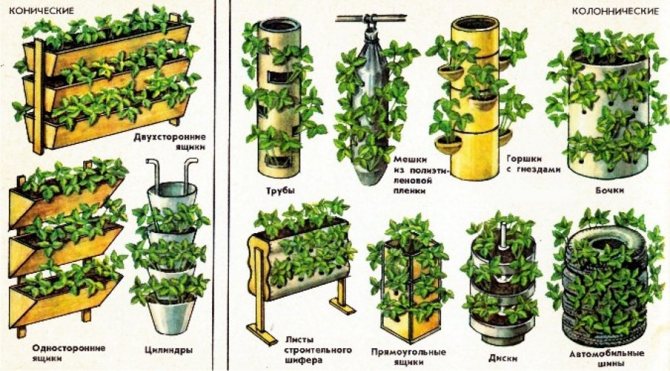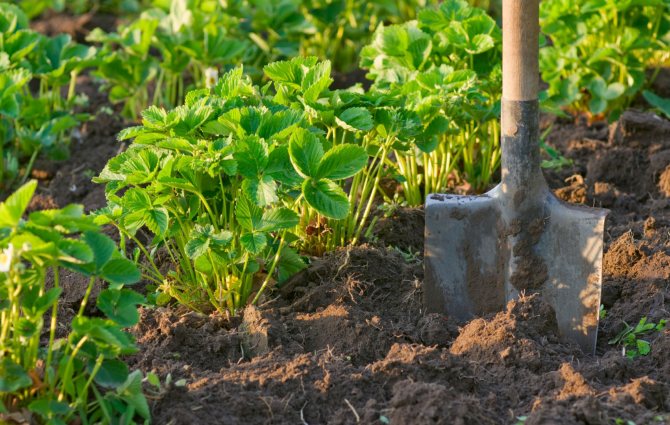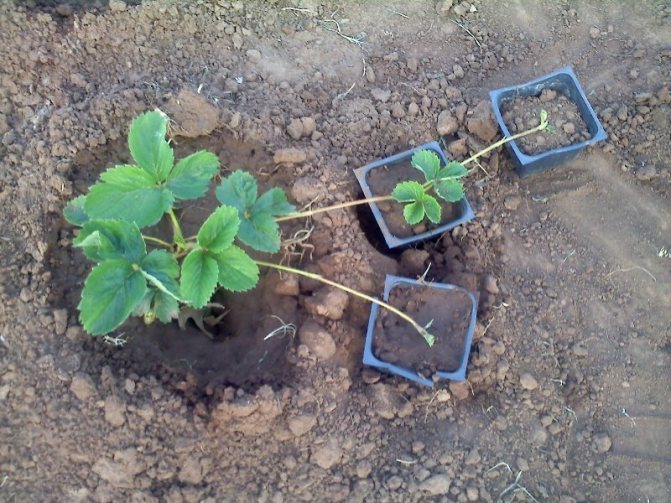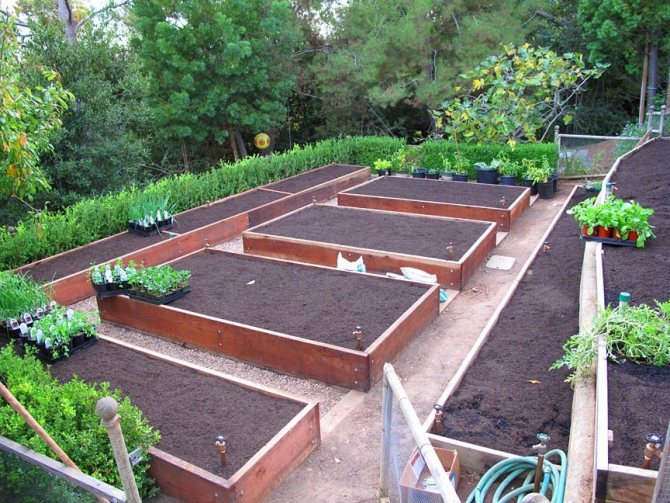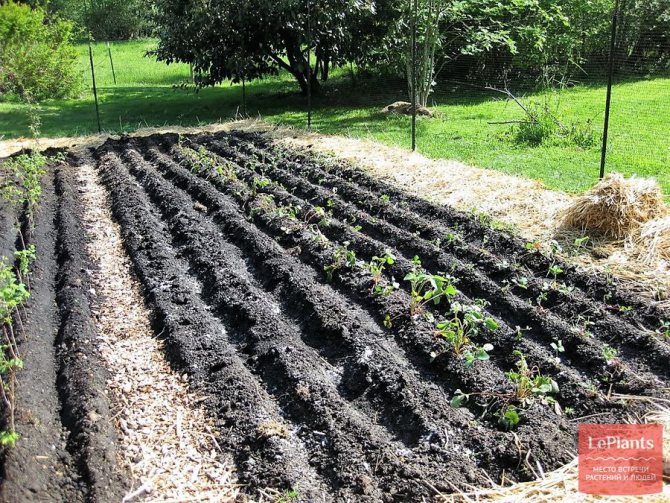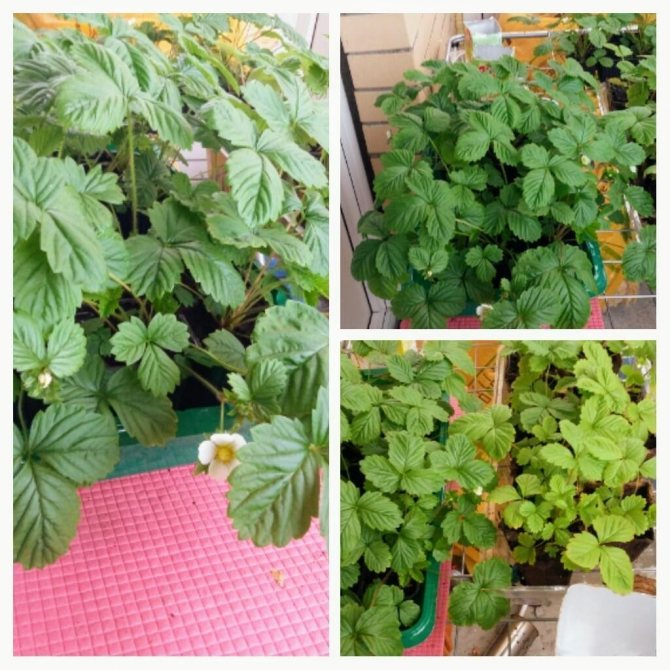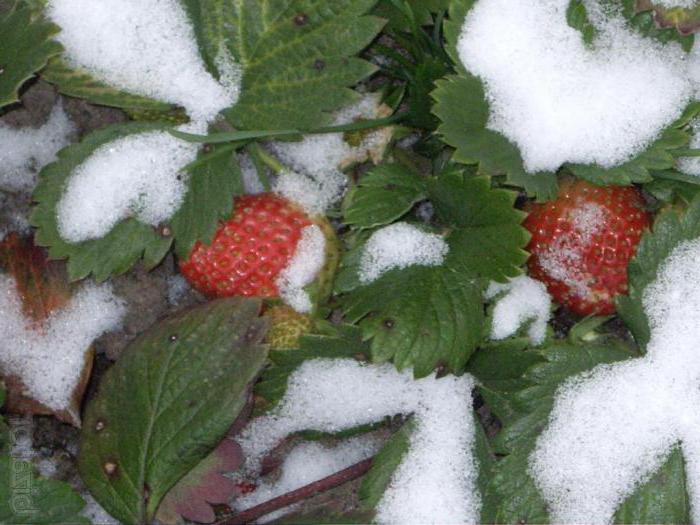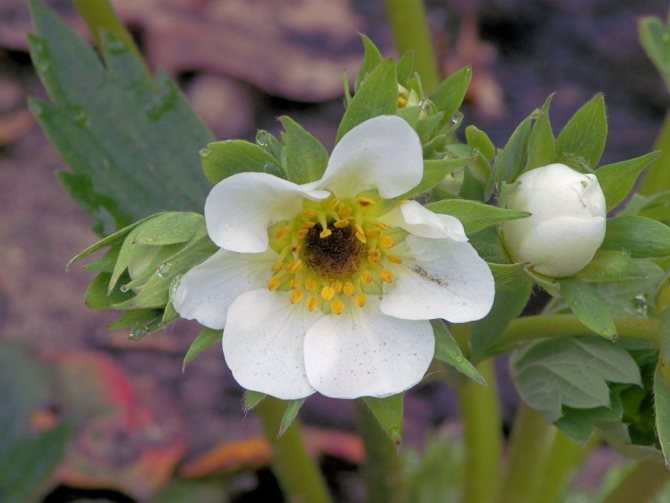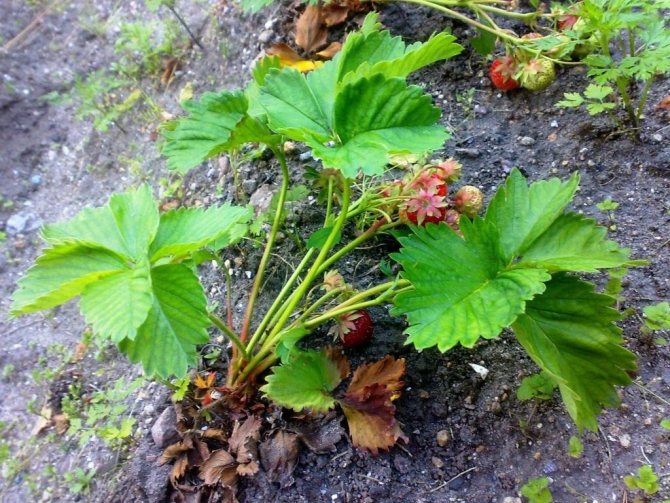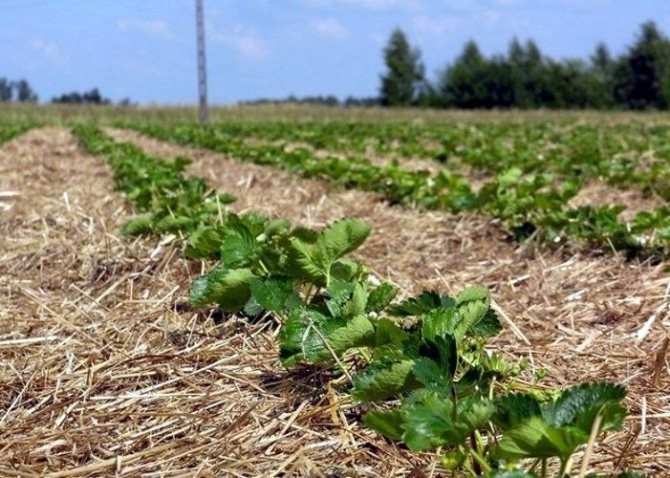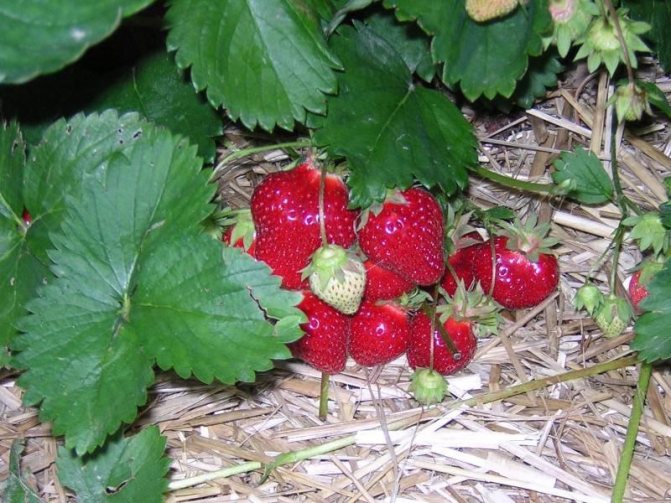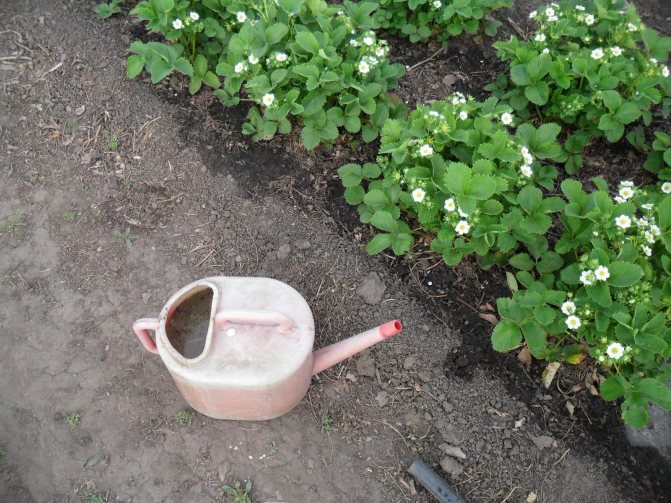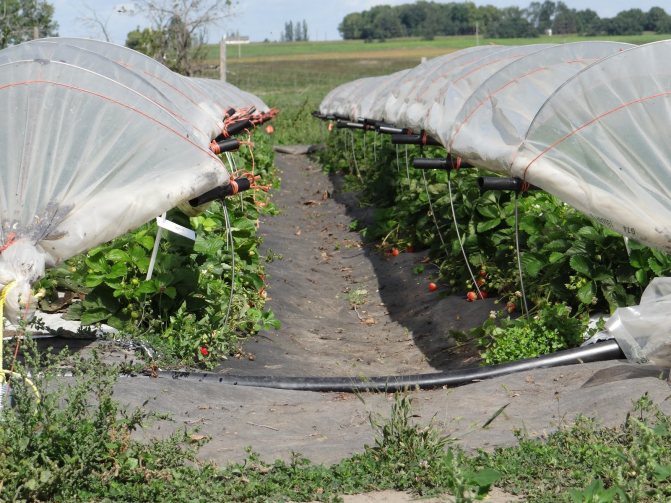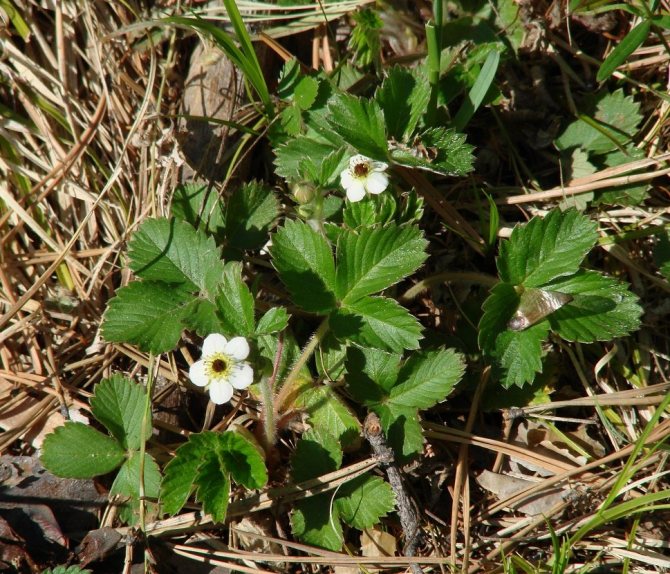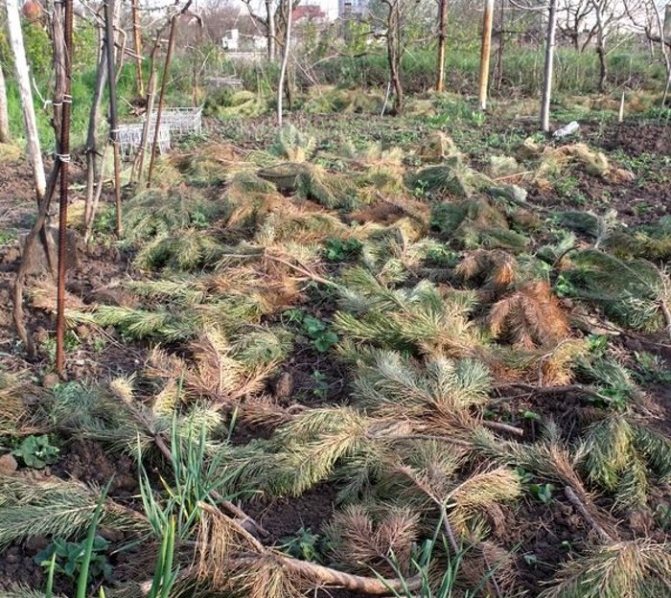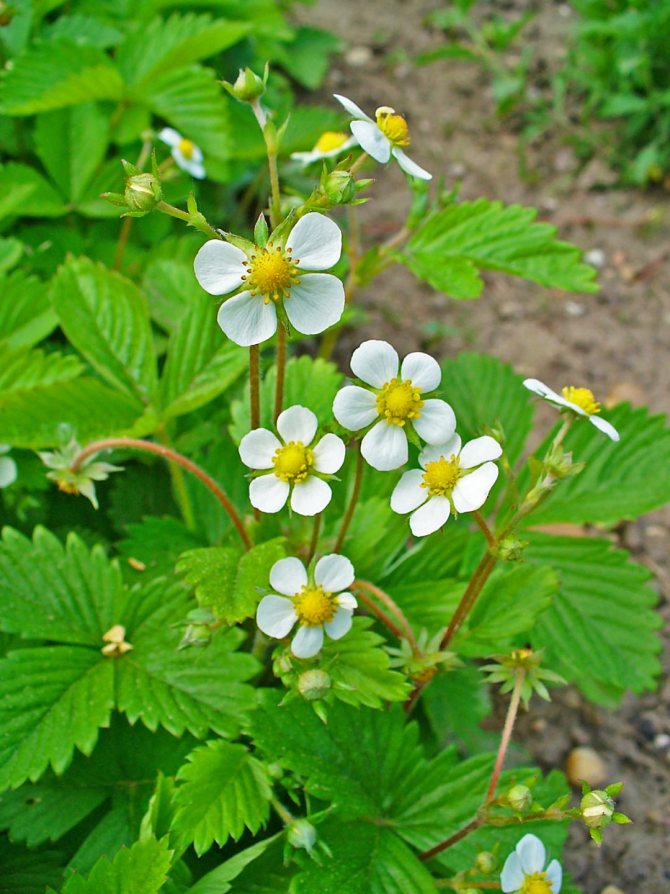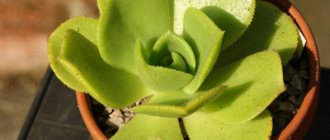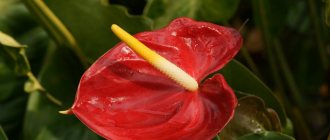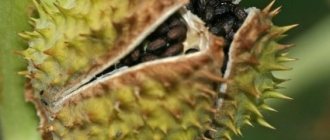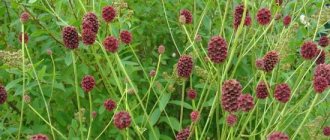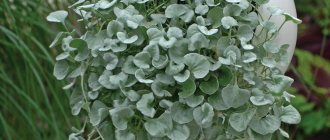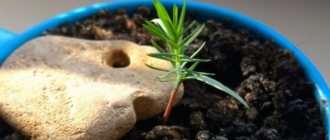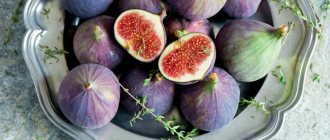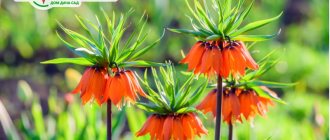Garden strawberries are the most common berry in amateur gardens. It is delicious, sweet, aromatic and very healthy. Many amateur gardeners call it strawberries, but this is not correct. Berry culture - strawberries exist on their own. It is not very large, not sweet or aromatic.
As a result of selection, numerous varieties and various types of garden strawberries, in particular, remontant, were created. But in this article we will talk about planting common garden strawberries and further caring for them. We will talk about remontant strawberries in a separate article.
Varieties and is it worth growing wild strawberries
Wild strawberry is a small berry variety. It is used as an ornamental plant in the garden and, of course, for delicious fruits. It is mainly brought to your site from the forest, simply by digging the bushes you like. Garden strawberries are much larger and more common in home gardens. You should definitely try to get wild strawberries on your site, they are unpretentious, do not require much maintenance and give good yields of fragrant berries. Gardeners note its unique taste and aroma.
Strawberry varieties differ in the size and shape of the berry, the habit of the bush and the timing of fruiting. Most Popular:
- Red-fruited: Alexandria, Ruyana, Baron Solemakher.
- White-fruited: Yellow miracle, Zolotinka.
- Hybrid varieties: Penelope, Raisa, Muscat.
How to properly care for garden strawberries
And how to properly care for garden strawberries in order to get a good harvest? Strawberry plantation care is determined by the characteristics of the strawberry growth. The spring vegetation of plants begins early, due to the reserves deposited mainly in the rhizomes; the subsequent development of leaves and roots, as well as flowering and fruit formation, are due to the nutrients entering the plant. After fruiting, the further development of the strawberry plant is directed to the renewal of the leaf apparatus, the formation of whiskers, the autumn laying of fruit buds for the next year's harvest, the creation of a supply of substances for the beginning of the growing season, as well as hardening during overwintering. With age, the development of the root system is weakened in strawberries, which is the main reason for a decrease in yield and a reduction in the period of use of the plantation.
Care for strawberries in the first half of the growing season should be aimed at improving the water supply regime, ensuring moderate (but not violent) leaf growth and obtaining a good harvest.
The strawberry plantation must be kept under black fallow, systematically fertilized with manure or humus and mineral fertilizers.
In early spring, as soon as the soil is ready for processing after the snow has melted, the plantation is cleaned of dry leaves, the covering material is removed and the row spacings are loosened with a cultivator, and in the rows between the plants with a hoe.
On non-irrigated areas, after this, mulch the rows with manure, humus, etc. should be carried out, spreading the mulch in a layer of 5-6 cm.
On irrigated areas, simultaneously with loosening, humus is sealed in rows, if it was not introduced during autumn processing.
Before harvesting produce 2-3 loosening and a shelf - as needed.On irrigated plantations, 1-3 watering is carried out on the green ovary and the same amount during the ripening period.
In order to care for garden strawberries as efficiently as possible, a continuous bed of straw, tree leaves and other materials should be laid out in non-mulched areas to protect the berries from contamination soon after flowering.
Leaving in the second half of the growing season - after harvesting - is associated with preparation for wintering and next year's harvest. He must create conditions for the best nutrition of plants, ensuring the regrowth of leaves, the laying of fruit buds and good hardening for the winter.
In the post-harvest period, 3-4 loosening and a shelf of weeds should be performed. For better development of the root system, it is necessary to slightly huddle the plants when loosening. This enhances plant nutrition and better formation of flower buds for the next year's harvest. Whiskers that appear at this time in large quantities are removed if they are not needed, since they greatly deplete the bushes and reduce the harvest of the next year.
On plantations where old leaves are damaged by mottling and dry out, it is useful to mow or prune them, which speeds up the natural change of leaves. It is necessary to mow in the first days after harvest and no later than mid-July. On uterine plantations and areas with normally developed and healthy leaves, mowing is not performed.
In cases of significant damage to strawberries with white spot and a mite, it is useful to prune the bushes. New roots develop at the same time. Heavily pruned bushes are thus rejuvenated and largely free of spotting and mites.
In the fall, loosening of the soil and easy hilling of the bushes are carried out.
Garden bed preparation and planting
When choosing a place for planting strawberries, it is important to consider that it does not tolerate excessive waterlogging of soils. Also, the berry needs a lot of sunlight, with a lack of it, you can forget about a good harvest. An important role is played by the quality of the soil, it should be loose, fertile, with an acidity not higher than 6. The best soil for strawberries is turf or humus soil.
The process of preparing the beds can be divided into three main stages:
- Clear the site chosen for planting.
- Dig up the ground, apply fertilizer.
- Mark and form the beds.
If they plan to plant strawberries in the spring, then the beds are dug up in September. If planting is planned for the fall, then they begin to prepare the soil two months in advance. The best fertilizers are compost, urea, superphosphate and potassium salt.
The beds are formed in different ways:
- Plain. They form narrow, elevated beds of about 20 cm.The bushes are planted at a distance of 30 cm from each other. Row spacing - 40 cm.
- Low bed (German). The point is to make a bed up to 80 cm wide and enclose it with sides. Broken brick or other material capable of retaining moisture well is used to fill the furrows.
- Vertical way. This method is suitable for small gardens.
Technology for growing garden strawberries: methods of planting in open ground
The timing of planting garden strawberries in the middle lane is early spring and late summer - early autumn (within the second half of August - the first half of September).
But autumn terms are preferable due to weather conditions and a greater possibility of using rooted mustache for planting.
Strawberries can be planted in one-, two- and three-line methods.
On large plantations, one- or two-line planting should be used, as more providing mechanized soil care.Planting distances should be given: with a single line 15-20 cm between plants in rows and 80 cm between rows; with two lines - 20 cm in rows, 40 cm between rows in stripes (ribbons) and 80 cm between stripes.
On irrigated plantations, planting should be carried out in furrows or deep ridges 60-100 cm wide (depending on the planting method), which are cut in advance by special plowmen.
To maintain the straightness of the rows, which makes it possible to mechanize the care of garden strawberries, planting must be done under a cord.
In recent years, a square-nesting method of planting has begun to be introduced on industrial strawberry plantations.
With this method of planting garden strawberries, nests of 4 plants are made in the corners of a square with a side of 12 cm, at a distance of 75-80 cm from the centers of the square in all directions. For the correct placement of the squares, cords are used: two control cords stretched along the edges of the site at the same distances along their entire length, multiples of the distances between the centers of the squares, and one landing with marks every 75-80 cm, stretched between the control ones in a direction perpendicular to them. Its marks must match the control cords.
When planting seedlings, pits are made by hand or with a scoop.
In order to ensure the best survival rate of seedlings, good development and yield, the technology for growing garden strawberries in the open field has determined the following rules that must be observed when planting.
- Plant the plants shallow, so as not to fall asleep "heart", as with such planting strawberries do not develop, often rot and die. Plants should not be planted too shallowly so that the roots are not exposed when the earth subsides. In a normal planting, the root collar should be at ground level.
- The ground should be firmly pressed to the roots.
- Cut the outer leaves, leaving 2 - 3 medium ones, this reduces the evaporation of moisture by the plant.
- To avoid wilting, you need to keep the seedlings moist (spray with water and shade): planting should be timed to coincide with falling rains or cloudy weather.
- After planting, watering - about one bucket for 6-10 plants, depending on the state of soil moisture, lining the holes with manure, humus or backfilling with dry earth. Repeat watering as needed.
Watch the video "Planting garden strawberries" to better understand how this agrotechnical technique is performed:
Pest control
Experienced gardeners often do not want to use chemical preparations for pest control; folk methods come to their aid.
Onion peel. The infusion effectively fights spider mites. 100 g of onion husks are poured with 5 liters of hot water, insisted for 120 days. Strain, add grated soap and spray to protect against pests.
Infusion of garlic. A good remedy for fighting earth mites. 100 g of chopped garlic is poured into 5 liters of water, filtered and sprayed with plants.
Ash. A soapy solution with the addition of ash is a win-win remedy for aphid control. For cooking, take 150 g of ash, 5 liters of water, boil and add no more than 25 g of grated laundry soap. When the first signs of damage to strawberries appear, they are sprayed with a cold solution.
Perlite for strawberries
Perlite is a volcanic rock formed by hydration. To obtain a porous material used in agricultural technology, the rock is heated. Then they are crushed and already used to grow various crops.
The material significantly improves the structure of the soil, retains moisture and prevents the formation of crust on the soil surface. The use of the supplement can be directed to different purposes:
- the coarse fraction is used as drainage;
- covering the top layer of the soil prevents the appearance of mold;
- storage of bulbs and tubers;
- good material for germinating seeds.
As you know, not only open ground is used for growing strawberries. You can do this in a greenhouse and at home, where a pot is used instead of the usual garden bed. Recently, the Dutch method of growing strawberries has been popular. This method allows you to harvest all year round, does not require special investments and has many more advantages.
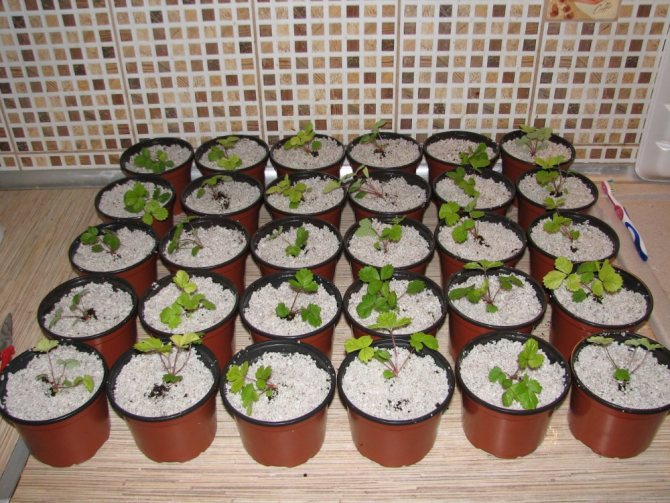
Perlite for strawberries
For cultivation, polyethylene bags or plastic containers are used, which are filled with perlite mixed with peat. Such a composition absorbs moisture and gives it up only if necessary. The bags are placed on the greenhouse racks at intervals of 50 cm.
In addition, it is good to add perlite to the soil for growing at home. It is also important here to decide what kind of land is needed for strawberries. It is advisable to make the composition yourself, using forest soil, high peat, perlite, humus and fine sand.
Note! To grow strawberry seedlings at home, you should not take land from the garden, since it may initially be infected with a nematode.
Mulching
This is a good agronomic technique that protects strawberries from drying out and pests. Mulching with freshly cut grass is an affordable method. Thanks to it, the structure of the soil improves, the roots are protected from temperature extremes, and the soil is not washed out or weathered. It is important to remember that the mulching layer should be at least 5-7 cm. Before placing the grass on the garden bed, it must be cleaned of weeds and watered well. You need to mulch strawberries twice a year: in the spring, so that the flower stalks do not touch the ground (prevention of diseases), and in the fall, in order to prevent freezing of the bushes. Mixing herbs with other plants gives a good effect:
- wormwood - its smell well scares away harmful insects;
- nettles - a reliable way to deal with snails and slugs;
- healthy tops of potatoes and tomatoes. The foliage is a natural insecticide. Its use does not allow garden pests to overwinter in the mulch layer.
How to disinfect the soil for strawberries
Strawberry soil can be contaminated. It hides the larvae of various insects, spores of dangerous fungi, infections. At home, the soil is steamed, but it is difficult to do this in a large area.
Therefore, it is necessary to carry out the following tillage. From the selected plot of land in the spring, you need to cut down not completely thawed layers of earth with a thickness of about 10 cm.Then put them in a prepared hole (1x1 m) so that the last layer is turned upside down. It is good to spill the layers with warm water and cover with polyethylene film. There should be small air gaps at ground level.
For two months the earth should "burn" under the film. Inside there is a decomposition of organic matter by microorganisms. When the temperature rises in the soil, all larvae, spores, and fungi die. Then the film is removed, and the ground is sieved to remove unburned residues. The soil is obtained free of pathogenic organisms, light, enriched with oxygen.
Sequence of work
After the bushes have faded and all the berries are ripe, you can start planting the shoots that have formed on the mustache. For this you need:
- leave a few healthy whiskers on the largest and most developed bushes;
- dig in the rosettes of new bushes and moisten the soil;
- after rooting, the rosette is cut off and, having dug out the bush, they are transferred to another place.
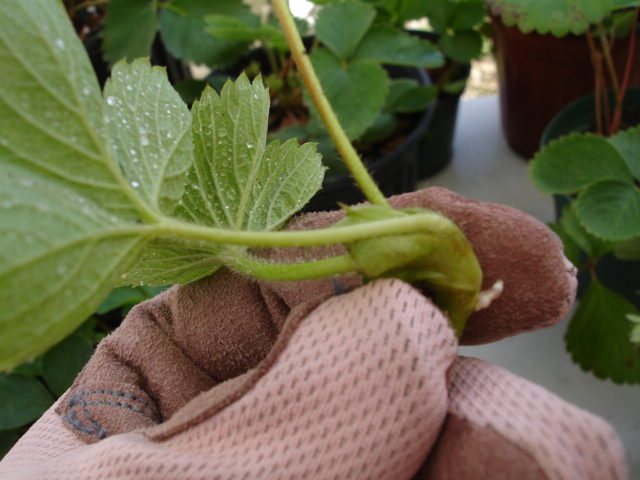

If there are well-developed bushes in the garden, then they can throw up to seventy mustache outlets. They are all transplantable. In this case, it is worth deciding what comes first - an increase in the number of bushes or their fruiting. A large number of whiskers takes away the strength of the plant, and it cannot bear a good harvest. The number of berries can be reduced by one third from the expected.
For all mustachioed strawberry varieties, mustache pruning is mandatory. Otherwise, the bushes will not be able to form berries.There is a certain peculiarity in the seedling of strawberries by the method of rooting shoots: you need to leave several bushes for reproduction, which will form mustaches and rosettes, and cut off the rest in the meadow.
In addition to harvesting, strawberries are also grown for decorative purposes. This applies to large-fruited varieties or the smallest. Often such strawberries are planted in pots or decorate balconies with them.
Secret number 2. Choosing a location
Strawberries are a light-loving culture, therefore, the ratio of the cardinal points should be a very important, fundamental principle in choosing a place for it. If you want to get a lot of berries from the plot and have well-developed plants, the beds must be located strictly from north to south.
In addition, the correct predecessor is important for garden strawberries. In no case should it be planted after potatoes or tomatoes (they are loved by common diseases), near or after plums (they are equally strongly affected by weevils and aphids). It is necessary to choose beds for garden strawberries after garlic, onions, dill, peas, as well as after green manure such as lupine, vetch, oats, radish and marigolds.
Warm beds will also be a good place for planting garden strawberries. Usually they are prepared in the fall, however, if time is lost, all operations can be performed in the spring: it is good to fill the structures with manure, compost, ash, organic residues, old leaves. It is easier to care for such beds, they yield earlier crops, they are easier to cover for the winter.
And remember, garden strawberries love loose soil!
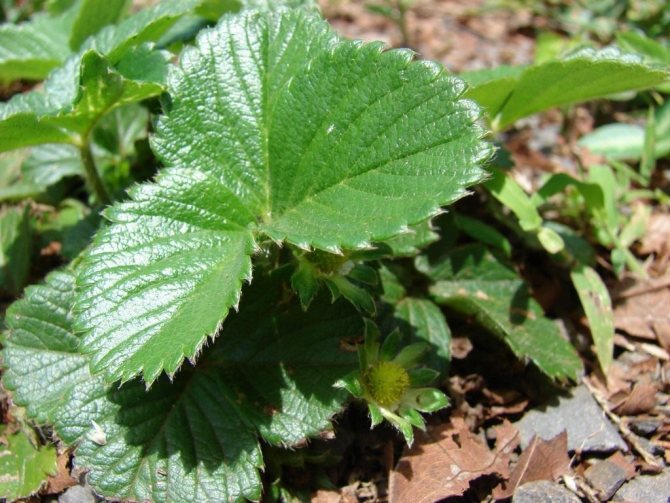

Garden strawberries, berry ovary.
Harvesting and drying
Wild strawberries are tasty and aromatic, they are used for making desserts. They are used to make preserves, jams, compotes, and freeze. Dried fruits and leaves are used to prepare medicinal tea.
Read on! How can strawberries be used in medicine?
Harvesting and drying berries
Ripe berries are picked without a stalk, carefully so as not to crush. It is best to collect strawberries in a wide basket or bucket. Do not wash the berries before drying. They are laid out in a thin layer on a baking sheet. It is better to cover the bottom with parchment paper. They expose the berries to the sun, put them indoors at night. Strawberries are dried for 5 days.
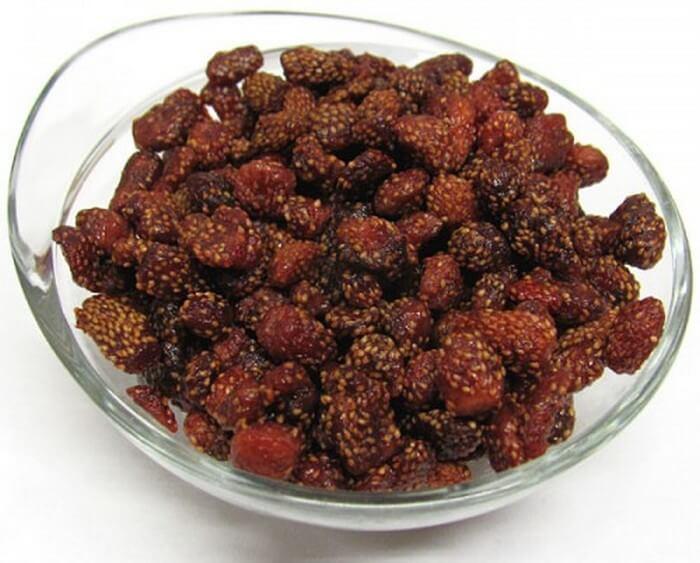

For long-term storage, the berries are poured into a rag bag.
It's important to know! Strawberries are harvested in dry weather.
Harvesting and drying of leaves
The leaves are harvested during flowering. Be sure to leave at least 2 pieces on the bush, otherwise the plant may stop bearing fruit or die. For drying, select undamaged leaves. Lay them out in one layer on parchment paper. They are dried in a dry, darkened, warm room.


Wild strawberry grows in sunny places. Prefers slightly acidic or neutral soil. With proper planting, timely care, it will delight you with tasty and healthy berries.
FOR DACHI-COMPROMISE
Given the relatively small volumes of annual planting of strawberries in summer cottages (about 50-100 plants), it is better to choose a compromise option with obtaining seedlings (according to the second method) from mother bushes on which fruiting is allowed. In this case, it is necessary to prepare a substrate from a mixture: soil, peat, humus, sand (in equal amounts). Fill containers with substrate and place them in small boxes. Use plastic pots with a diameter and height of 6-7 cm as containers (make a hole in their bottom to drain excess water). Soak the pots with the substrate by lowering the boxes with them in water (the holding time is the end of the release of air bubbles from the substrate). From the moment the first rosettes appear and until July 15-20, install pots with a substrate on a ridge with mother plants and at the same time pin them into them, without separating the mustache suitable for rooting the rosette.
It is convenient to pin rosettes in pots with metal staples (thickness 3 mm, length 3-3.5 cm).During this period, regularly remove dead and old leaves of mother plants that shade ripening berries and rosette pots. After July 20, remove any whiskers that form on the plants.
After 10-15 days, separate the pots with rooted rosettes from the mother bushes and put them in boxes for growing anywhere. Caring for them is to apply (in hot sunny weather), regular watering or spraying with water.
Potted strawberry seedlings can be stored painlessly for several days before planting. Before planting in the ground, spill the seedling pots with water so that the plant with a lump of earth can be freely removed by turning the pot over and knocking on the bottom.
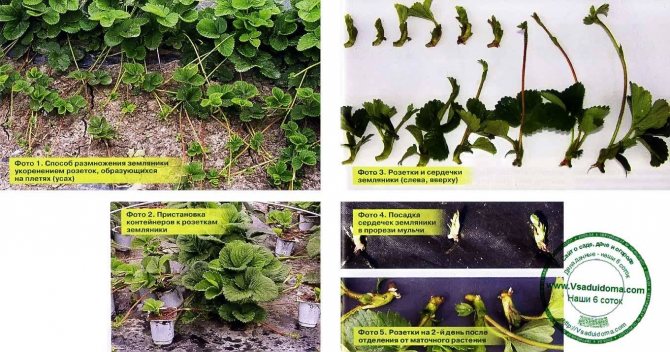

Tips and tricks from experienced gardeners
There are few general tips to know how to properly prepare a strawberry bed. It is also worth listening to the opinion of experienced gardeners:
- It is important to analyze the soil from the site to determine the level of its acidity. This will help in the selection of fertilizers that can significantly change the chemical composition of acidic or alkaline soil.
- In the case of shallow groundwater or marshy soil, the gardener must make high beds or hills on which to plant seedlings in the future.
- To successfully control weeds, it is necessary to treat the soil with herbicides and immediately cover it with a darkened film. It will be possible to open it in a few weeks. During this time, all weed crops will die.
When growing strawberries, not only the composition of the soil plays an important role, but also the climatic conditions. It is necessary to approach the choice of the variety with special responsibility. Certain growing conditions must be suitable for him. Next, you need to choose the right site and strictly follow the landing rules.
When is the best time to start a strawberry plantation?
Mid to late August is the best time to start a new plantation. You can, of course, plant strawberries in the spring (this work is carried out from the end of April to the end of May, while the soil has a reserve of moisture), but usually in the spring there is sorely lack of time, there are a lot of other things in the garden. And return frosts can destroy young immature plants. And if you plant strawberries at the end of summer, when it is no longer so hot, then by the middle of autumn it has time to get stronger and grow green mass, so that before winter it leaves with a cap of leaves that protects the plants from freezing.
Increasing the number of seedlings by dividing
Reproduction of garden strawberries by dividing the bush is a common practice, and it is used if there is a shortage of plants. So they transplanted into new land and especially rare and valuable specimens of bushes. This ensures the safety of one of the divided parts.
It is important to take into account that the reproduction of strawberries by dividing the bush is possible only if the plant is more than three years old. Yearling plants cannot undergo such a procedure, the number of dots is very small. Due to the separation of the horns, it is possible to successfully plant mustacheless varieties. The number of seedlings on an adult bush is more than fifteen.
Strawberry propagation
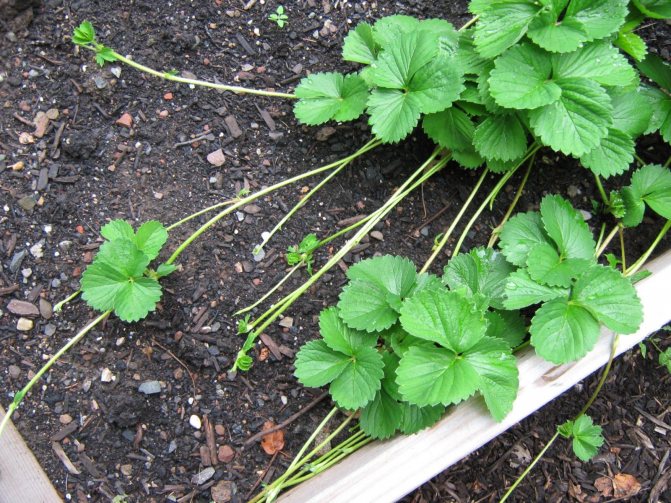

During the growing season of strawberries, creeping cord-like shoots (whiskers) are formed unevenly. In spring they grow slowly and remain in their infancy for a long time. The growth of the whiskers becomes more active in June, and reaches the greatest activity in July - the first half of August. At the end of August, the formation of swallowing stops.
- Creeping shoots of strawberries develop from the axillary buds of the lower leaves of the horn and represent a chain of whiskers of several orders of branching. As a rule, daughter plants, which are called rosettes, appear on an even internodes of a mustache of any order. On odd internodes, lateral branches are formed.After the appearance of an underdeveloped leaf, the growth of the whisker stops and a rosette of first-order leaves with root primordia at the base develops, which takes root upon contact with moist soil. From the bosom of the first leaf of the rosette, a second-order mustache develops, outwardly similar to the continuation of the first-order mustache. A branching appears on it in the same sequence and a socket is formed, as on the main lash.
- The laying of flower buds in strawberries occurs in autumn, in September - October, when the length of the day decreases to 10-12 hours, and the air temperature drops. Repairing varieties of small- and large-fruited strawberries are capable of planting flower stalks in the summer.
- For the laying of flower stalks, the amount of precipitation in the previous period is of great importance. With sufficient moisture, they are laid earlier and there are more of them in quantity. The formation of rudimentary inflorescences continues until the end of the growing season. In spring, at a positive temperature, further flower formation occurs. They appear in the same sequence in which they were laid in the fall: first on the most developed horns, then on the rest. This continues for about three weeks.
- The number of peduncles and flowers on the bushes depends on the variety and age of the plants. On young bushes, flower stalks form strong, with a large number of flowers. The laying of additional inflorescences is also possible in the early spring period when growing strawberries under small-sized film shelters.
The vast majority of strawberry varieties have perfect flowers with normally developed stamens and pistils. Such varieties are pollinated with their pollen and can be planted in a single-variety massif.
Transplanting strawberries to a new location
Bushes need to be transplanted, which have been bearing fruit in one place for 3-4 years, since the seedling has already used up all the nutrients from the ground, and the crop begins to grow scarce. You can transplant the bushes at any time during the growing season. However, when transplanting a bush during flowering, there is a high risk that the plant will not take root in a new place. It is best to do this a couple of weeks before or after flowering.
For transplantation, bushes are selected that have been growing in one place for more than 2 years.
Important! To improve the structure and composition of the soil in the place where berry crops used to grow, it is worth planting vegetables for several seasons in a row.
HOW TO PLANT THE UTERINE?
Each of these methods must correspond to a system for growing mother plants. In the first method, the planting of mother plants should be sparse (no more than 4-5 plants per 1 sq. M). This provides sufficient space for rooting outlets. In this case, it is possible to occupy not every aisle, but through one.
It should be borne in mind that with a higher density of placement of mother plants, the multiplication factor (the number of outlets per plant) decreases. But when separating the outlets (according to the third method), the planting density of mother plants will not have such a value.
DELICIOUS AND HEALING
When in the forests and meadows, among the lush silky grass, strawberries begin to fill with ruby color, the unique aroma spreads far around. “It seems that somewhere in a basin, sugar jam from a bouquet of roses, honey, apples and pineapples has boiled and evaporated,” wrote a great connoisseur of Russian nature, DP Zuev, who called strawberries the most fragrant vitamin in nature. Of all the known wild-growing medicinal plants, there is hardly one as rich in nutrients as strawberries. In its leaves, for example, tannins, ascorbic acid (250-280 mg), essential oils are found. Berries contain a lot of sugars (up to 15%), citric, malic and phosphoric acids, carotene (0.3-0.5 mg), vitamin C (20-50 mg). They contain essential oils, manganese and other macro- and microelements. There is a lot of iron in the seeds, it is also present in the rhizomes. Strawberries are useful for people of all ages, but especially for children.By the way, biologically active substances are better absorbed when eating strawberries with fresh milk, cream or sour cream. And strawberry jam or strawberry compote are unmatched either in aroma or taste. Strawberries are not only tasty, nutritious, but also have medicinal properties. The German doctor Kneipp left us an aphorism: "In the house where strawberries and blueberries are eaten, the doctor has nothing to do." In one of the old Russian medical books, the following lines are devoted to strawberries: "Water from strawberries ... is mixed with ordinary drinking and drives any wetness of wrecking sweat from the body, and opens the respiratory veins, and strengthens the heart and gives strength, and destroys the stone inside." Writer Vladimir Soloukhin in his story "The Third Hunt" gives interesting information about the healing effect of wild strawberries. A close relative of the writer had a severe liver pain, and no medical remedies helped, and only thanks to the use of fresh strawberries, the patient was completely cured of a serious illness. For medicinal purposes, berries and leaves are usually used, less often rhizomes. The berries are harvested in the morning, when the dew subsides, or in the evening. At this time, they are most fragrant. Pluck strawberries with sepals. Leaves are harvested during flowering and fruiting. They are cut off without petioles and dried in the attic or in another well-ventilated area. Rhizomes are dug up in the fall, when the aboveground part of the plant begins to wilt. Peel and dry until they break with a bang. Traditional medicine recommends using fresh strawberries for atherosclerosis, high blood pressure, neurasthenia, insomnia, gout, kidney stones, liver and biliary tract diseases, as well as for catarrh and stomach ulcers, spleen diseases. Fresh juice from strawberry berries, taken on an empty stomach in 4-6 tbsp, is also healing. spoons. With scurvy or liver disease, it is recommended to drink 4-8 dessert spoons. Eczema with suppuration, cracks, scabs, which sometimes cannot be eliminated with the help of expensive medicines, are often successfully cured with strawberries. To do this, ripe berries are kneaded, smeared with a thick layer on a clean linen cloth and applied to a sore spot. This is done for 3-4 days in a row. Cosmetologists recommend using grated berries to remove acne and freckles, in order to increase the elasticity of the skin of the face and neck, and prevent the formation of wrinkles. However, it must be remembered that in some people, strawberries cause redness of the skin, rash, itching, dizziness, urge to vomit and other unpleasant phenomena. They quickly disappear when you stop taking berries. In folk medicine in many countries, the medicinal properties of strawberry leaves are widely used. In Poland, they are treated for atherosclerosis, kidney, bladder and skin diseases. For gallstones and kidney stones, spleen diseases, gastritis, bronchial asthma, suppuration in the mouth and throat, a decoction of the leaves is recommended by German and English folk healers. In domestic folk medicine, a decoction or infusion of dry leaves is used for rickets, diathesis, gout, gastritis, colitis, hemorrhoids, jaundice, bronchial asthma, diabetes mellitus, and salt metabolism disorders. Compresses are applied for skin diseases (rashes, acne, lichens). To prepare the broth, 20 g of chopped leaves are poured with 1 glass of boiling water and kept on low heat for 10 minutes. Then they insist for 2 hours, filter and take 2 tbsp. spoons 4 times a day. For infusion, take 2 tbsp. tablespoons of leaves, pour 2 cups of boiling water and leave for 4 hours. Strain and drink 1 / 2-1 glass 2-3 times a day. Strawberry leaves, along with dried berries, are popularly substituted for tea, especially in the North, and they also drink it for colds.According to traditional medicine, such a drink has a beneficial effect on emaciated and nervous people, improves sleep, normalizes the functioning of the digestive system, dilates blood vessels, enhances contraction of the uterus, and is an effective remedy against scurvy. Recently, flower-herbal teas, which include strawberries, have become more and more popular. For example, tea obtained by brewing one part of dried leaves of strawberries, blackberries, wildweed, raspberries, linden flowers and St. John's wort with the addition of a small amount of black currant leaves and thyme herb has a tonic, hematopoietic and anti-sclerotic effect. This drink improves metabolism, and in taste and aroma is not inferior to the famous green Chinese tea.
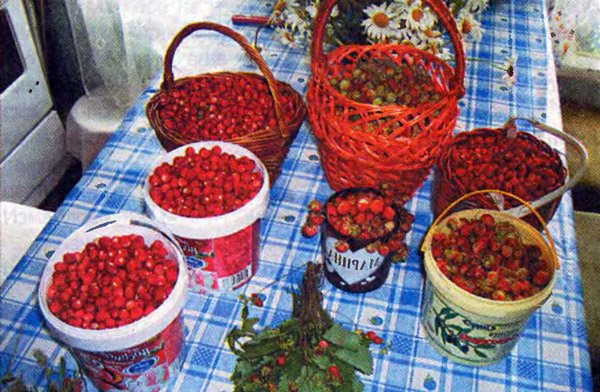

Suitable timing for planting seedlings
The climatic conditions of the area are important. For Siberia, the central and warm regions of the country, the timing of planting strawberries in spring is different:
- For the southern regions of Russia, the suitable period for planting strawberry bushes is the beginning of March.
- In the Moscow region and the middle lane, it is optimal to plant garden strawberries in the second half of April.
- Transplanting strawberries in the spring in the northern regions is carried out in the first two weeks of May.
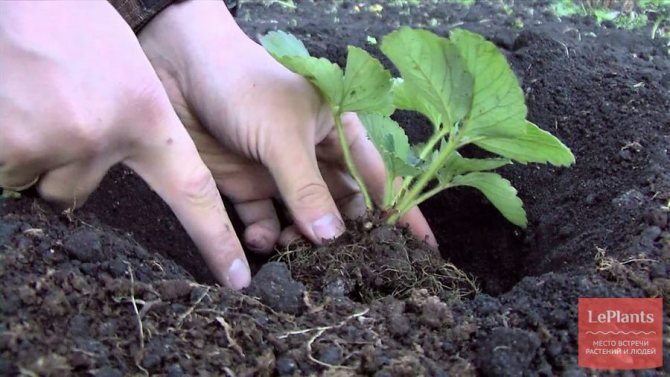

ON THE PICTURE: After the end of the night frost, you can start planting strawberry seedlings.
The spring months are great for transplanting seed-grown garden strawberries. The seedlings are hardened, and as soon as the threat of frost subsides, they are transplanted to the beds. In this case, you will receive a harvest already in the year of planting.
Whatever variety your strawberries are, planting in the spring at the right time allows the bushes to grow full and healthy, and show good productivity.
In the Urals and Siberia, planting strawberries in spring is the only chance to give them strength before winter, after going through a full development cycle (in other areas, autumn planting of garden strawberries is also possible). The bushes will have time to adapt and grow before the cold weather in order to meet the harsh winter in full readiness. Strawberry beds will be ready for a luxurious harvest next season.
Care
The propagation of strawberries and the viability of its shoots directly depend on the correct care of the bushes and their proper preparation for winter. Strawberries are unpretentious to care for in winter, the main factor for a successful winter is the shelter of bushes under a layer of snow. The freezing of the leaves is not scary for the berry, it is worse if the roots are open. To do this, it is necessary to spud the root system in advance. If the winter is without snow, then the beds with strawberries are covered with spruce branches or artificial materials. It is very important to insulate the bushes only after the first slight frosts have passed. So the plant will get used to the cold and endure the winter more easily.
PICKING OUTLETS WITHOUT MUSHROOMS
When diving sockets (according to the third method), separate them from the whiskers as they form (regularly) or at several times. A strawberry rosette, suitable for rooting, is a plant formed on a mustache, with 2-3 leaves, root rudiments at the bottom of the horn and a mustache continuing at least 5-10 cm long.
When separating the rosettes, leave a part of the whisker no more than 1 cm long to better strengthen the plants in the substrate. Then place the cut outlets in a plastic bag, moisten them with water and leave in a cool place until the next day.
Root the strawberry rosettes on the "nursery" beds on a well-moistened substrate (peat, soil, sand in a ratio of 2: 1: 1). For 1 sq. m of a dive ridge, 100-150 outlets can be placed if they are planted in shallow (1-2 cm) furrows according to the scheme 7 × 7 cm, 10 × 5 cm or 10 × 10 cm. The sockets can also be rooted in containers (hollow peat, paper , plastic, etc.) with a size of at least 5 × 5 cm, placing them in boxes.
After picking the sockets, be sure to water them.Water beds with ripped-out outlets periodically, providing fine-drop sprinkling. Since high humidity is required for good rooting of outlets, first cover the beds with burlap or lutrasil, and then with plastic wrap on the frame.
On average, the growth rate of roots at strawberry rosettes is 2-3 mm per day. Based on this, the rooting time of the rosettes and the formation of standard seedlings is 20-30 days. Sockets are usually rooted by 80-95%.
BIOPORTRAIT
Wild strawberry belongs to the Rosaceae family. It is a perennial herb. The aerial part consists of a short branching stem 10-15 cm long, which grows very slowly in height. The branches of the stem are called horns. Kakhdy of them has a rosette of leaves and ends with a growth cone. It is often called the "heart". From the axils of the basal leaves, long creeping shoots - whiskers, rooting at the nodes, develop. The root system is fibrous, well branched. Almost all the roots are concentrated at a depth of 30 cm. In winter, strawberries leave with green leaves, and with a favorable overwintering with them, they also come out from under the snow. Leaves are long-petiolate, trifoliate, collected in a rosette. The flowers are white with a double cup. Strawberry blooms in late May - June. At night and in inclement weather, the flowers droop, which protects them from rain and dew. They also droop after pollination, so the fruits that ripen in June-July are hanging. Berries (ovoid bright red berry-shaped achenes) on the surface and inside have many dry seeds, nuts. Strawberries are propagated by these seeds and mustache shoots.
Harvesting
The result of all work and effort is the harvest. At the same time, it is important to know a few rules that will allow you to keep the beautiful appearance of berries longer:
- You need to pick berries in the early morning hours or in the evening, but before they are covered with dew. The berry must be dry.
- It is better not to put berries that have rotted a little to healthy ones, otherwise everything will start to deteriorate. Strawberries are harvested fully ripe or slightly unripe, they will ripen when stored.
- The berries must be plucked from the stalk so that they do not deteriorate and rot.
- The first few times the berries can be harvested every one or two days, after that this gap widens.
- Reduce the amount of watering before harvesting.
The shelf life of strawberries is up to 7 days; varieties with a denser skin are grown for commercial purposes.
Features of caring for strawberries in spring in Siberia
Siberia has a sharp changeable continental climate. To grow strawberries there, first you need to find out which variety is suitable for this region. It must be resistant to severe frosts, pests and decay, and have the ability to quickly regenerate. Also, the variety should bear fruit, despite the lack of sunlight.
The most suitable types for this:
- Amulet;
- Daryonka;
- Lord.
Planting and care will be the same as in normal conditions, but it is worth carefully preparing the bushes of the plant for wintering. For this, it is advisable to make mulch from pine needles and straw. And the best thing to do this is at the end of October. And in the spring, after the mulch is removed, you need to actively warm up the soil under the plants. The same preparation radiance-1 or rotted horse or chicken droppings will help in this.
Secret number 1. Only high-quality seedlings
It's not news to anyone that the popular saying "cheap fish is a nasty yushka" says not only about the soup. This rule is very well suited to the choice of strawberry seedlings. Unfortunately, in an effort to save money, we often buy low quality planting material, thereby unconsciously delaying the receipt of a full harvest of long-awaited berries, sometimes for a whole year.High-quality seedlings are the key to quick survival, high potential of plants and excellent results of the labor spent on them.
What is worth buying?
When choosing a new variety of garden strawberries, be sure to pay attention to the condition of the offered plants. The best option are annual seedlings grown in individual cups with 2 - 3 developed leaves and a root system of at least 5 cm.
What not worth buying?
Do not buy seedlings if they have a clearly unhealthy appearance, signs of disease, an open root system. Of course, such planting material is cheaper, but its survival rate is low, and the presence of diseases guarantees a deliberately weak harvest and the need to spend efforts on combating them.
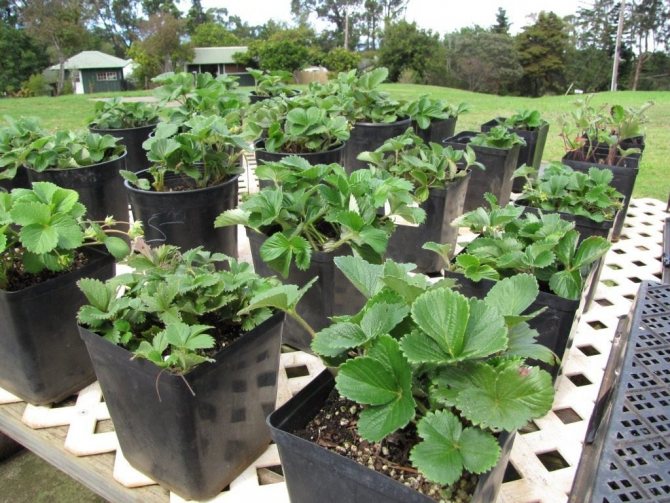

Seedling of garden strawberry.

